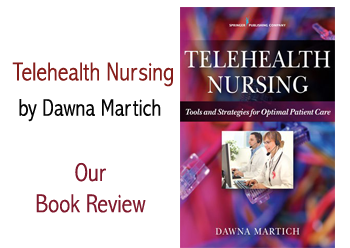Book Review: Telehealth Nursing
by June Kaminski, RN MSN PhD(c)
Editor in Chief
I was recently approached by Springer Publishing to review their new book: Telehealth Nursing: Tools and Strategies for Optimal Patient Care (2017) written by Dawna Martich and I am happy to share my impressions of this valuable book.
First, to put this book into context, it is helpful to introduce the author of the book. “Dawna Martich, MSN, RN, received her bachelor’s and master’s degrees in nursing from the University of Pittsburgh and has been practicing as a nursing education specialist for adult learners for three decades. After working in neurology, postanesthesia recovery, home care, and physician practice management, she served as a direct telephonic nursing care provider for an organization with a satellite office in Pittsburgh, Pennsylvania.
Shortly thereafter, Ms. Martich became one of several training managers for a telephonic organization. Although the organization had a specific computerized clinical documentation system, it lacked approaches to help nurses transition from direct care to the telephonic care environment. After orienting hundreds of telephonic nurses in Pittsburgh, Arizona, Hawaii, Seattle, and Baltimore, it became clear that telephonic nursing care would stay as a viable avenue in the health care industry. She structured approaches to help nurses fine-tune their communication skills and develop an ease with computerized documentation” (Book insert).
Impressive aspects of this book include the theoretical yet practical approach. Background, context, and practical how-tos are a consistent feature across all 27 chapters. These chapters are clustered into four sections, with ready-to-use guidance on how to assess and care for clients through telehealth technologies. The book is available through Springer Publishing as a 410-page, 15.2 x 22.9 cm soft-cover book with access to a pdf sample chapter and overview. The book does have a decided American focus, but the content can still prove valuable for Canadian nurses.
Key Features of the book include:
- It helps nurses understand the keys to successful telehealth nursing
- It teaches enhanced, specialized communication techniques including “active listening”
- It guides nurses in assessing patients using only the sense of hearing/active listening
- It includes case studies, algorithms, patient teaching resources, and more
- It reviews body systems and disease processes with application exercises
The first section of the book provides an overview of the history and evolution of telehealth, from telephone based care to the sophisticated telehealth equipment used today. This section includes chapters on:
Section I: Introduction
- Evolution/History of Telenursing
- Assessment Techniques: Communication and Active Listening
- Professional Preparation for Telehealth Nursing
- Patient/Client Perspective on Telehealth Nursing
The layout and content of the book make it suitable for nursing students as well as professional nurses. It is easy to follow and read, with bursts of theoretical content interspersed with practical exercises that readers can practice and apply. It does a good job of helping readers understand the patient or client’s perspective within this care milieu and how nurses can put them at ease, and enrich each telehealth experience. The carefully constructed scripts, for instance, for active listening, can be role played within the education or practice setting to help nurses become comfortable with using telehealth techniques.
“Including all the information necessary for safe, competent practice, this hands-on resource walks nurses through telehealth guidelines and procedures to optimize patient communication, perform assessments, and provide effective care of chronic conditions. Replete with case studies and sample dialogue to mimic real-life telehealth situations, introductory chapters cover patient and nurse perspectives on both sides of the telephone” (Springer book webpage).
Sections 2 and 3 offer detailed information and guidance in assessing clients using a body systems approach and how to work with people with various body system disorders.
Section II: Introduction to Body Systems
- Integumentary System
- Respiratory System
- Cardiovascular System
- Gastrointestinal System
- Musculoskeletal System
- Neurologic and Sensory Systems
- Genitourinary System
Section III: Introduction to Body System Disorders
- Disorders of the Integumentary System
- Disorders of the Respiratory System
- Disorders of the Cardiovascular System
- Disorders of the Gastrointestinal System
- Disorders of the Musculoskeletal System
- Disorders of the Neurologic and Sensory Systems
- Disorders of the Genitourinary System
- The Patient/Client With Diabetes Mellitus
- The Patient/Client With HIV/AIDS
The approach used in these chapters is both practical and valuable. Specific questions to ask, points to consider, and advice to share are part of the practical user-friendly approach to telehealth delivery. This approach facilitates nursing education as well as practicing nurses who wish to enter the field of telehealth.
Case studies at the end of each chapter further reinforce the common-sense approach suggested.
Section 4 concludes with chapters related to specific semantics of telehealth nursing, such as documentation, care issues, and work environments.
Section IV: Additional Aspects of Telephonic Patient/Client Care
- Patient/Client Care
- Review of Laboratory Values and Diagnostic Tests
- Documentation
- Tools for Telephonic Care
- Work Environments
- Issues and Solutions
- The Nurse as Client
Conclusion: The Rest of the Story
Dawna Martich has done a great job in penning a book that can be used as a teaching tool and a resource guide. This book could easily be integrated as a textbook in a nursing informatics or technology in nursing course, since it is chockfull of usable scripts, exercises, and case studies that lend themselves well to the classroom setting. It can also be required reading for nurses who are moving into a telehealth position, since it provides the basic nuts and bolts of telehealth assessment, communication, and solving common problems and issues.









